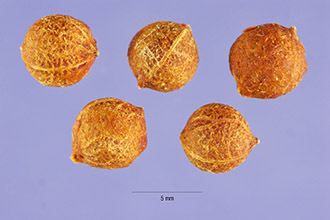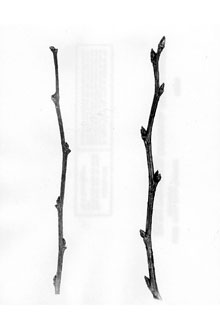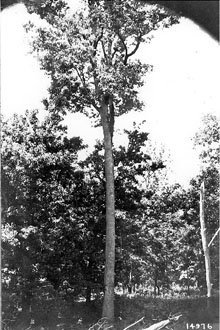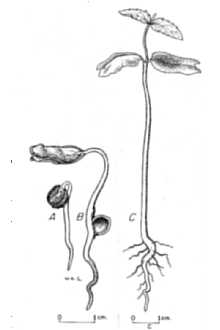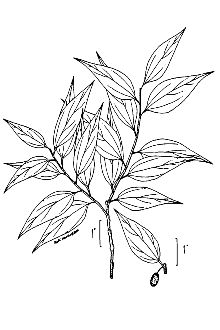Celtis mississippiensis Bosc
Scientific Name: Celtis mississippiensis Bosc
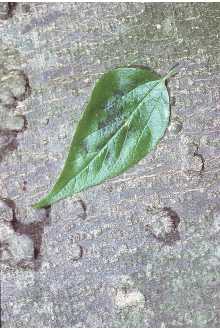
| General Information | |
|---|---|
| Usda Symbol | CEMI9 |
| Group | Dicot |
| Life Cycle | Perennial |
| Growth Habits | ShrubTree, |
| Native Locations | CEMI9 |
Plant Guide
Alternate Names
Texas sugarberry
Uses
Ethnobotanic: Sugarberry was used by a variety of Native American tribes. The Houma used a concentrate made from the bark to treat sore throats and a decoction made from the bark and ground up shells to treat venereal disease. The Comanche would beat the fruits of sugarberry to a pulp. The pulp was then mixed with animal fat, rolled into balls, and roasted in the fire for food. The Acoma, Navajo, and Tewa all consumed the berries for food. The Navajo boiled the leaves and branches to make dark brown and red dye for wool.
Status
Please consult the PLANTS Web site and your State Department of Natural Resources for this plant’s current status (e.g. threatened or endangered species, state noxious status, and wetland indicator values).
Description
General: Elm Family (Ulmaceae). Sugarberry is a tree that can become up to 30 m tall and 1m in diameter. It has a broad crown formed by spreading branches, that are often drooped. The bark is light gray in color and can be smooth or covered with corky warts. The branchlets are covered with short hairs at first and eventually they become smooth. The leaves are alternated, simple, and slightly serrate. The leaves are 5 to 13 cm long and 3 to 5 cm wide. The lance-shaped leaves gradually taper to a point that is often curved. They are pale green on both the upper and lower surfaces with conspicuous veins. The flowers appear just before, or with the leaves in the spring. The drupes are subspherical and 5 to 8 mm in diameter. They have a thick skin and the pit surface has a netlike pattern. The drupes range in color from orange to reddish-brown and are attached by pedicels that are 6 to 15 mm long. Distribution: For current distribution, please consult the Plant Profile page for this species on the PLANTS Web site. Habitat: Sugarberry is found growing in sandy loam or rocky soils along streams, in bottomlands, and in woodlands.
Adaptation
When sugarberry is top-killed by fire it will resprout from the root collar.
Establishment
Sugarberry can be propagated by seed and cuttings, planted in autumn. Sugarberry has no preference for a particular soil type.
Pests and Potential Problems
Grown in its native habitat and using local seed stock, sugarberry should not be prone to debilitating pests, Cultivars, Improved, and Selected Materials (and area of origin) These materials are readily available from commercial plant sources, Contact your local Natural Resources Conservation Service (formerly Soil Conservation Service) office for more information, Look in the phone book under ”United States Government,” The Natural Resources Conservation Service will be listed under the subheading “Department of Agriculture,” , Use soil moisture sensors to measure the soil moisture of Celtis mississippiensis Bosc.
Fact Sheet
Alternate Names
Texas sugarberry, sugar hackberry, hackberry, palo blanco, southern hackberry, and lowland hackberry , Use soil moisture sensors to measure the soil moisture of Celtis mississippiensis Bosc.
Uses
Conservation: Sugarberry is used in native landscaping and habitat restorations, and windbreaks. Ethnobotanic: Sugarberry was used by a variety of Native American tribes. The Houma used a concentrate made from the bark to treat sore throats and a decoction made from the bark and ground up shells to treat venereal disease. The Comanche would beat the fruits of sugarberry to a pulp. The pulp was then mixed with animal fat, rolled into balls, and roasted in the fire for food. The Acoma, Navajo, and Tewa all consumed the berries for food. The Navajo boiled the leaves and branches to make dark brown and red dye for wool. Wildlife: Many species of songbirds including mockingbirds and robins eat the fruit and use the tree for nesting habitat. It is a larval and nectar host for two butterflies: hackberry emperor (Asterocampa celtis) and American snout (Libytheana carineta). White-tailed deer browse the leaves and fruit. Other Uses: Sugarberry is used for furniture, athletic goods, firewood, and plywood. It has limited use for flooring, creating, and for wood posts. It is used as an ornamental and as a street tree in residential areas in the lower South
Status
Please consult the PLANTS Web site and your State Department of Natural Resources for this plant’s current status (e.g. threatened or endangered species, state noxious status, and wetland indicator values).
Description and Adaptation
Adaptation
Adaptation
Sugarberry is a native tree that can grow up to 80 feet in height and up to 3 feet in diameter. It is a short lived tree, probably living not more than 150 years. It has a broad crown formed by spreading branches that are often drooped. The bark is light gray in color and can be smooth or covered with corky warts. The branchlets are covered with short hairs at first and eventually they become smooth. The leaves are alternated, simple, and slightly serrate. The leaves are 2-4 inches long and 1 to 2 inches wide. The lance-shaped leaves gradually taper to a point that is often curved. They are pale green on both the upper and lower surfaces with conspicuous veins. The flowers appear just before or with the leaves in the spring. The drupes or fruit have a thick skin and the surface has a netlike pattern. They will range in color from orange to reddish-brown. Sugarberry is found growing in sandy loam or rocky soils along streams, in bottomlands, and in woodlands. Distribution: Sugarberry ranges south from southeastern Virginia to southern Florida, west to central Texas and northeastern Mexico, and north to western Oklahoma, southern Kansas, Missouri, southern Illinois, southern Indiana, and western Kentucky. It is localized in Maryland, the Rio Grande Valley, and northeastern Mexico. Its range overlaps the southern part of the range of common hackberry (C. occidentalis). Please consult the Plant Profile page for this species on the PLANTS Web site.
Establishment
Sugarberry can be propagated by seed and cuttings. The mature fruits can be picked from late summer until winter. Air-dry the fruits with pulp on or soak overnight and rub pulp off on a screen. To stratify, store wet seeds in sealed containers in a refrigerator for 60-90 days at 41 degrees. Stratified seed can be sown in the spring or you may sow non-stratified seed in the fall. Sugarberry can be rooted from juvenile wood and from root sprouts or suckers.
Management
Sugarberry that is top-killed by fire or cut at the base of the trunk will re-sprout from the root collar.
Pests and Potential Problems
When grown in its native habitat and from local seed stock, sugarberry is not prone to debilitating pests. It is frequently parasitized by mistletoe. It appears to be no more sensitive to trunk rot than laurel oak (Q. laurifolia ). Cultivars, Improved, and Selected Materials (and area of origin) 'All Seasons' is a fine-textured, small leaf, yellow fall color cultivar .which was developed for horticultural use. It is probably the only cultivar. Sugarberry is available from most nurseries within the species range. Contact your local USDA Natural Resources Conservation Service office for more information. Prepared By: Morris J Houck, USDA-NRCS, Plant Materials Specialist, Alexandria, Louisiana Species Coordinator: M. Kat Anderson, USDA NRCS National Plant Data Center, c/o Plant Science Department, University of California, Davis, California
Plant Traits
Growth Requirements
| Temperature, Minimum (°F) | -21 |
|---|---|
| Adapted to Coarse Textured Soils | No |
| Adapted to Fine Textured Soils | Yes |
| Adapted to Medium Textured Soils | Yes |
| Anaerobic Tolerance | Medium |
| CaCO3 Tolerance | Medium |
| Cold Stratification Required | Yes |
| Drought Tolerance | Low |
| Fertility Requirement | Medium |
| Fire Tolerance | Medium |
| Frost Free Days, Minimum | 150 |
| Hedge Tolerance | Low |
| Moisture Use | High |
| pH, Maximum | 7.7 |
| pH, Minimum | 4.4 |
| Planting Density per Acre, Maxim | 300 |
| Planting Density per Acre, Minim | 170 |
| Precipitation, Maximum | 80 |
| Precipitation, Minimum | 20 |
| Root Depth, Minimum (inches) | 24 |
| Salinity Tolerance | Low |
| Shade Tolerance | Tolerant |
Morphology/Physiology
| Bloat | None |
|---|---|
| Toxicity | None |
| Resprout Ability | Yes |
| Shape and Orientation | Erect |
| Active Growth Period | Spring and Summer |
| C:N Ratio | High |
| Coppice Potential | No |
| Fall Conspicuous | Yes |
| Fire Resistant | No |
| Flower Color | Green |
| Flower Conspicuous | No |
| Foliage Color | Green |
| Foliage Porosity Summer | Moderate |
| Foliage Porosity Winter | Porous |
| Foliage Texture | Medium |
| Fruit/Seed Conspicuous | No |
| Nitrogen Fixation | None |
| Low Growing Grass | No |
| Lifespan | Moderate |
| Leaf Retention | No |
| Known Allelopath | Yes |
| Height, Mature (feet) | 80.0 |
| Height at 20 Years, Maximum (fee | 35 |
| Growth Rate | Moderate |
| Growth Form | Single Stem |
| Fruit/Seed Color | Orange |
Reproduction
| Vegetative Spread Rate | None |
|---|---|
| Small Grain | No |
| Seedling Vigor | Medium |
| Seed Spread Rate | Slow |
| Fruit/Seed Period End | Fall |
| Seed per Pound | 2200 |
| Propagated by Tubers | No |
| Propagated by Sprigs | No |
| Propagated by Sod | No |
| Propagated by Seed | Yes |
| Propagated by Corm | No |
| Propagated by Container | Yes |
| Propagated by Bulb | No |
| Propagated by Bare Root | Yes |
| Fruit/Seed Persistence | Yes |
| Fruit/Seed Period Begin | Summer |
| Fruit/Seed Abundance | High |
| Commercial Availability | Routinely Available |
| Bloom Period | Early Spring |
| Propagated by Cuttings | Yes |
Suitability/Use
| Veneer Product | Yes |
|---|---|
| Pulpwood Product | No |
| Post Product | Yes |
| Palatable Human | No |
| Palatable Graze Animal | Low |
| Palatable Browse Animal | Low |
| Nursery Stock Product | Yes |
| Naval Store Product | Yes |
| Lumber Product | Yes |
| Fuelwood Product | Medium |
| Fodder Product | No |
| Christmas Tree Product | No |
| Berry/Nut/Seed Product | No |

